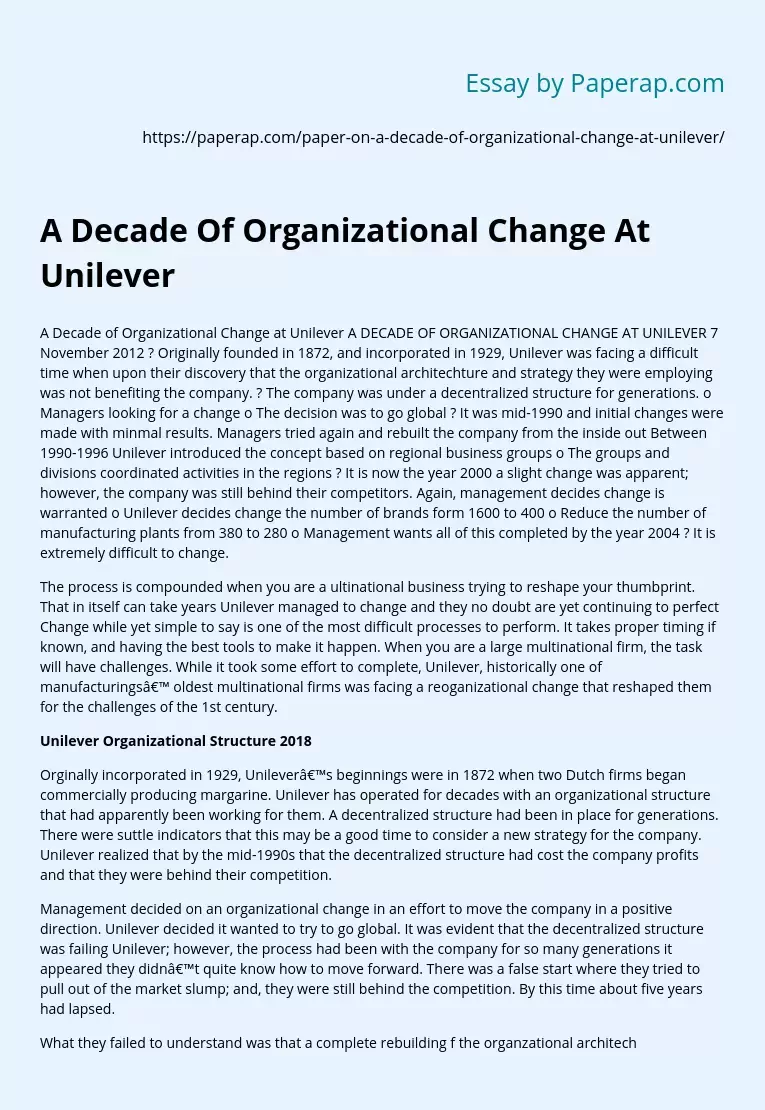Unilever Organizational Structure 2018
The process is compounded when you are a multinational business trying to reshape your thumbprint. That in itself can take years Unilever managed to change and they no doubt are yet continuing to perfect Change while yet simple to say is one of the most difficult processes to perform. It takes proper timing if known, and having the best tools to make it happen. When you are a large multinational firm, the task will have challenges. While it took some effort to complete, Unilever, historically one of the manufacturings’ oldest multinational firms was facing a reorganizational change that reshaped them for the challenges of the 1st century.
Originally incorporated in 1929, Unilever’s beginnings were in 1872 when two Dutch firms began commercially producing margarine. Unilever has operated for decades with an organizational structure that had apparently been working for them. A decentralized structure had been in place for generations. There were subtle indicators that this may be a good time to consider a new strategy for the company.
Unilever realized that by the mid-1990s that the decentralized structure had cost the company profits and that they were behind their competition.
Management decided on an organizational change in an effort to move the company in a positive direction. Unilever decided it wanted to try to go global. It was evident that the decentralized structure was failing Unilever; however, the process had been with the company for so many generations it appeared they didn’t quite know how to move forward. There was a false start where they tried to pull out of the market slump; and, they were still behind the competition.
By this time about five years had elapsed.
What they failed to understand was that a complete rebuilding f the organizational architecture, as they were trying to do includes everything from the inside out and it will take some time. This included the formal organizational structure, control systems and incentives, processes, organizational culture, and people. The move toward globalization was presenting a challenge to Unilever managers; however, the competition was ahead and Unilever was trying to improve its position in the market. They had to get better leverage for themselves. Realm begins to take place.
Between Unilever introduced a new structure based on regional business groups that included a number of divisions that focused on specific products. The groups and divisions coordinated activities in the regions and helped to drive down costs. Even though Unilever implemented changes it was now the year 2000 and the company was still behind its competition. There is still room for more changes. This time, the decision was to trim down a sizable number of brands from 1600 to 400 and reduce the number of manufacturing plants from 380 to 280 all of this is to be done by attrition by the year 2004.
When they created the divisions, they created two global divisions, a product division, a food division, and a home personal care division. Within each division are a number of regional business groups that do the developing, marketing etc. Unilever has divisions in Europe, North America, Latin America, and Asia. To conclude, while over a decade, Unilever took patience and due diligence to perfect a business system that was best suited to change their Organizational Architecture, and one would like to think that they are ever-evolving in their processes. This will keep them positioned as they forge the challenges of the 21st century
Unilever Organizational Structure 2018. (2019, Dec 05). Retrieved from https://paperap.com/paper-on-a-decade-of-organizational-change-at-unilever/

